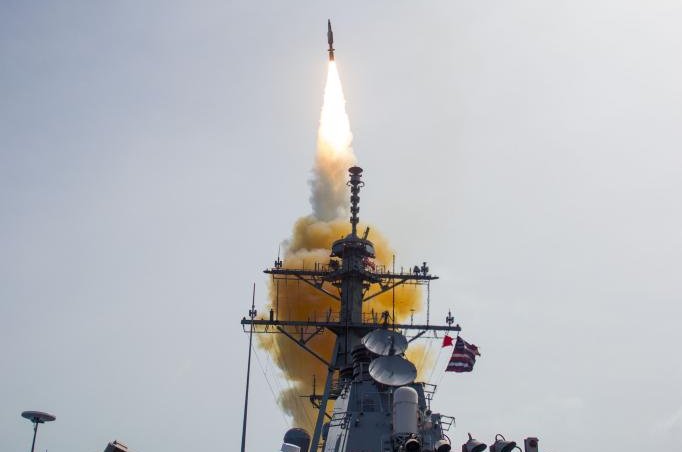A missile is launched from the USS John Paul Jones during a Missile Defense Agency and U.S. Navy test over the Pacific Ocean by the AEGIS baseline system in 2014. Photo courtesy Missile Defense Agency
April 29 (UPI) -- Lockheed Martin has exercised a $13.9 million in support of the U.S. Navy's AEGIS combat system.
The AEGIS speed to capability development contract includes systems engineering, modeling and simulation, and design cycles. The contract also includes completion of the development and fielding of the AEGIS Baseline 9 AEGIS Weapon System and integrated AEGIS Combat System on AEGIS Technical Insertion for 12 configured destroyers as well as TI 12 and TI 08 configured cruisers, the Defense Department announced Friday.
Ninety-seven percent of the work will be performed in Lockheed Martin Rotary and Mission Systems' plant in Moorestown, N.J., and 3 percent in Johnstown, Pa. Work on the contract is expected to be completed by May 2020.
Naval fiscal 2019 research, development, test and evaluation funding in the amount of $1.9 million has been obligated at time of award and will not expire at the end of the current fiscal year.
Last year Lockheed signed an $8.9 million contract for Speed to Capability development and work on the Baseline 9 system.
AEGIS, which stands for Advanced Electronic Guided Interceptor System, is integrated into ships. The automated and centralized computerized and radar weapon system can track targets -- sometimes more than 100 at once, according to the Navy.
The weapons system is installed on 22 U.S. Navy cruisers and 62 destroyers.
The first engineering development mode of the SPY-1 radar system was installed in the test ship USS Norton Sound in 1973. The first AEGIS ship, the USS Ticonderoga, was commissioned in 1983 and deployed six months after commissioning.
AEGIS baselines are released every four years but software updates are distributed rapidly to handle emerging threats and add high-priority capabilities, an effort the Speed to Capability development aims to improve.
"Lockheed Martin applies unique software engineering methodologies to enable the U.S. Navy to reduce the time, cost, and effort required to create, deliver, and maintain the systems on the surface and submarine fleets," according to the company.
The system realized more than $166 million in cost avoidance over the last three years, according to Lockheed.
"We focus on updates that provide significant performance improvements and capability while keeping software changes to a minimum, which means about 5,000 to 15,000 lines of source code as opposed to millions of lines," Tomy Joseph, ASToC manager for Lockheed, said in a post on its website. "The teams take full advantage of the Aegis Common Source Library and the open-architecture design of Aegis to deliver capabilities to the fleet."













